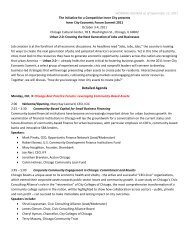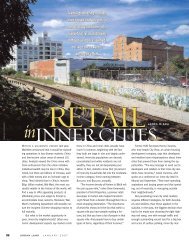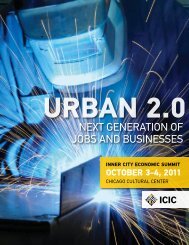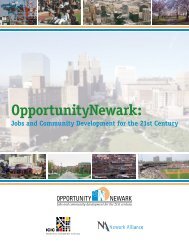Larysa Salamacha - Initiative for a Competitive Inner City
Larysa Salamacha - Initiative for a Competitive Inner City
Larysa Salamacha - Initiative for a Competitive Inner City
Create successful ePaper yourself
Turn your PDF publications into a flip-book with our unique Google optimized e-Paper software.
Session 2:<br />
The Role of Industrial Land in<br />
the <strong>City</strong> Landscape<br />
Copyright © 2012 ICIC 2
The Role of Industrial Land in the <strong>City</strong><br />
Landscape<br />
Don Graves, President’s Council of Jobs and <strong>Competitive</strong>ness<br />
and U.S. Treasury<br />
Adam Kamins, ICIC<br />
Michael Holzer, Local Economic and Employment Development<br />
Council<br />
<strong>Larysa</strong> <strong>Salamacha</strong>, Baltimore Development Corporation<br />
Kate Sofis, SFMade and Urban Manufacturing Alliance<br />
Lorrie Louder, Saint Paul Port Authority<br />
Copyright © 2012 ICIC 3
The Value of Industrial Activity in Cities:<br />
Overview and Lessons from ICIC’s Work<br />
Adam Kamins<br />
Research Practice Manager<br />
September 20, 2012
Why Industrial Is Poised <strong>for</strong> a Comeback in the U.S.<br />
Increased energy costs and ―greening‖ favor domestic production<br />
Crude oil prices have increased from roughly $20/barrel a decade ago to<br />
nearly $100/barrel today<br />
Residential market has cooled in recent years<br />
Decreased competition <strong>for</strong> available land<br />
Overseas production can be less efficient <strong>for</strong> a variety of reasons, including:<br />
Lack of IP protections<br />
Concerns about product quality<br />
Increased wages in Asia’s industrial heartland<br />
Critical change is mix, not level of activity<br />
Shift away from traditional manufacturing and towards transportation and<br />
logistics, warehousing, and wholesale<br />
Copyright © 2011 ICIC 5
Case <strong>for</strong> Industrial Activity in Cities<br />
Equity<br />
<strong>Inner</strong> cities need jobs; between 1998-2009, the 100 largest inner cities<br />
lost nearly 3% of their job base while the rest of their regions grew by 5%<br />
Efficiency<br />
Midwestern industrial land, <strong>for</strong> example, can be redeployed to fuel growth<br />
Environment/Energy<br />
Re-focusing industrial activity in cities reduces supply chain costs, which<br />
has a positive impact on bottom lines and the environment<br />
Assets<br />
These include large centers of population, proximity to transportation<br />
assets, and large firms/institutions that are located in cities<br />
With these factors in mind, ICIC has focused in recent years on industrial<br />
strategies in a number of cities, including:<br />
Philadelphia, PA<br />
Detroit, MI<br />
Saint Paul, MN<br />
Copyright © 2011 ICIC 6
Lessons from Saint Paul: Wages and Education<br />
Industrial jobs are associated with higher wages and lower barriers to entry<br />
than those comprising the Saint Paul economy as a whole<br />
This creates more potential opportunities <strong>for</strong> inner city residents<br />
Average St. Paul Wages, 2008<br />
Source: Bureau of Labor Statistics, ICIC Analysis<br />
Share of Jobs that Demand High School<br />
Diploma or Less, 2008<br />
Copyright © 2011 ICIC 7
Lessons from Saint Paul: Fiscal Impact of Industrial Development<br />
Based on comparable cost of city services analysis and city budget data, we<br />
calculated the impact of various types of development on Saint Paul and built a<br />
model that can be customized based on various budget line items<br />
Expenditures Associated with Every Dollar of Revenue Generated, 2011<br />
Source: ICIC Analysis<br />
Industrial activity generates a budget surplus relative to other uses<br />
This is consistent with other findings conducted by firms that specialize in<br />
fiscal impact modeling, such as Tischler Bise<br />
Copyright © 2011 ICIC 8
The Role of Industrial Land in the <strong>City</strong><br />
Landscape<br />
Don Graves, President’s Council of Jobs and <strong>Competitive</strong>ness<br />
and U.S. Treasury<br />
Adam Kamins, ICIC<br />
Michael Holzer, Local Economic and Employment Development<br />
Council<br />
<strong>Larysa</strong> <strong>Salamacha</strong>, Baltimore Development Corporation<br />
Kate Sofis, SFMade and Urban Manufacturing Alliance<br />
Lorrie Louder, Saint Paul Port Authority<br />
Copyright © 2012 ICIC 9
Chicago Planned Manufacturing Districts—Case<br />
Study<br />
Presented by Mike Holzer<br />
Director, Economic Development<br />
mike@leedcouncil.org<br />
LEED Council (DBA)
The Problem—Industrial Displacement on Chicago’s Near<br />
North Side in 1980’s: Foreign Competition, Pressure <strong>for</strong><br />
Alternative Land Use & Case-By-Case Zoning Decisions at<br />
the Local, Ward-Level<br />
• Chicago’s industrial job loss: <strong>for</strong>eign competition (Germany & Japan), wage<br />
competition from lower wage states (Arkansas and Mexico’s Maquiladora<br />
region) & lack of owner investment<br />
• Young Urban Professionals jobs in FIRE industries downtown and housing<br />
on industrial fringe apply land use pressure on existing industry<br />
• Developers convert vacant loft buildings on edge of historic Clybourn<br />
Industrial Corridor to rental housing—1st zoning change Piano Lofts, 1985<br />
• Real Estate speculation on remaining sites increases pressure on existing<br />
firms to sell, move or close up<br />
• Investment by existing firms is put on ―HOLD‖ due to lack of political<br />
leadership on land use, lack of city industrial policy<br />
• Resulting industry & job loss in the North River Industrial Corridor in<br />
1980’s: firms reduced from 1,200 to 600 and job loss from 40,000 to 20,000<br />
jobs
LEED Council Response<br />
• Study impact of job/industry loss and models <strong>for</strong> land use solutions:<br />
NYC Garment District and Seattle Industrial Sanctuary<br />
• Engage area companies: determine viability & obstacles to growth;<br />
gauge commitment to land use solution (PMD); develop leadership<br />
• Engage nearby residential groups: understand impact of job loss;<br />
develop leadership<br />
• Findings: 75% of workers live in <strong>City</strong> & 50% of that group live within<br />
3 miles of plants; ―head-of-household‖ jobs; plant closings directly<br />
impact nearby communities<br />
• Create first Planned Manufacturing District (PMD) <strong>for</strong> Clybourn<br />
Corridor (1988) similar to ―Lakefront Protection Ordinance‖ &<br />
elevate case-by-case ward level zoning decisions to Plan<br />
Commission level
Objections to the PMD<br />
• Industry is ―dead‖ and will never come back<br />
• No one wants industrial jobs<br />
• The PMD is anti-free market<br />
• The PMD will kill the burgeoning housing market<br />
• Old industrial loft buildings outdated <strong>for</strong> business uses<br />
• Highest and Best Use is whatever price a square foot of<br />
dirt will fetch on the market
Our Experience—Business &<br />
Community Response<br />
• Land use assurance promoted reinvestment particularly by local family owned firms<br />
• Business growth in the Goose Island PMD: 25 firms employing 1,000 workers in<br />
1991; 100 firms employing close to 5,000 workers in 2012<br />
• Industrial jobs pay ―Head-of-Household‖ wages, are full time and provide benefits;<br />
barriers to entry <strong>for</strong> industrial jobs are fewer<br />
• Outdated Clybourn Corridor loft bldgs buffered high end residential to the east in<br />
Lincoln Park and heavy industry to the west and provided needed retail space<br />
resulting in home owner support <strong>for</strong> the PMD<br />
• The housing market moved to less restricted areas fueling growth in the Bucktown,<br />
Wicker Park, Ukrainian Village and Lincoln Park communities<br />
• Highest and best use is nuanced and complex—mfg. jobs have a jobs multiplier of<br />
3.5 jobs; locally produced goods sold mostly outside the city and creating wealth in<br />
the community; taxes receipts are greater <strong>for</strong> industry
Closing Thoughts/Lessons Learned<br />
• PMDs are useful land use and Economic Development tools but…<br />
• PMD’s need well-thought boundaries, well-developed leadership &<br />
stakeholder investment. Less well-planned PMD’s are less successful.<br />
• Other supports are necessary to create successful industrial parks:<br />
– Model Industrial Corridor Planning to create parks that are: safe, accessible &<br />
functional, competitive & marketable, manageable & attractive<br />
– Infrastructure & transit spending to accomplish the above<br />
– Corridor management and continued city support<br />
– Funding to address high cost of environmental clean up & site prep, such as<br />
TIF<br />
– Job training and education
The Role of Industrial Land in the <strong>City</strong><br />
Landscape<br />
Don Graves, President’s Council of Jobs and <strong>Competitive</strong>ness<br />
and U.S. Treasury<br />
Adam Kamins, ICIC<br />
Michael Holzer, Local Economic and Employment Development<br />
Council<br />
<strong>Larysa</strong> <strong>Salamacha</strong>, Baltimore Development Corporation<br />
Kate Sofis, SFMade and Urban Manufacturing Alliance<br />
Lorrie Louder, Saint Paul Port Authority<br />
Copyright © 2012 ICIC 16
Preservation of Industrial Maritime Waterfront<br />
Baltimore, Maryland<br />
WHY? Retention of existing maritime/ industrial businesses<br />
WHAT? Maritime Industrial Zoning Overlay District (MIZOD)<br />
WHO? <strong>City</strong> of Baltimore in collaboration with private sector<br />
businesses, property owners and the Maryland Port<br />
Administration<br />
WHEN? Initial legislation 2004, on-going updates<br />
WHERE? Baltimore’s industrial shoreline
HOW WAS THE MIZOD IMPLEMENTED?<br />
• Increase in rezoning requests (industrial to non-industrial)<br />
• 2004 – a Baltimore Development Corporation study<br />
reports investment in port facilities may be deferred due<br />
to uncertainty in city’s policy regarding change of use.<br />
• 2004 - Baltimore’s Planning Department issues a ‘white<br />
paper’ stating need <strong>for</strong> industrial waterfront preservation<br />
• 2004 - MIZOD legislation introduced and adopted<br />
• Baltimore Industrial Group (BIG) <strong>for</strong>med<br />
• 2009 – MIZOD extended to 2024, ‘opt out’ provision<br />
added.<br />
• Trans<strong>for</strong>m Baltimore –new zoning code legislation to be<br />
introduced October 2012 which incorporates MIZOD.
LESSONS LEARNED<br />
• You must have an organized industrial business<br />
constituency that speaks <strong>for</strong> itself<br />
• You must be aware of and understand your assets.<br />
Awareness and understanding brings appreciation and<br />
a commitment to preserve the assets.<br />
• There must be political will to listen and to act<br />
• Establishing public policy is not a static process
<strong>Larysa</strong> A. <strong>Salamacha</strong><br />
Managing Director of Business Development<br />
Baltimore Development Corporation<br />
lsalamacha@baltimoredevelopment.com
The Role of Industrial Land in the <strong>City</strong><br />
Landscape<br />
Don Graves, President’s Council of Jobs and <strong>Competitive</strong>ness<br />
and U.S. Treasury<br />
Adam Kamins, ICIC<br />
Michael Holzer, Local Economic and Employment Development<br />
Council<br />
<strong>Larysa</strong> <strong>Salamacha</strong>, Baltimore Development Corporation<br />
Kate Sofis, SFMade and Urban Manufacturing Alliance<br />
Lorrie Louder, Saint Paul Port Authority<br />
Copyright © 2012 ICIC 22
REALIZING THE POTENTIAL OF<br />
URBAN MANUFACTURING IN SAN<br />
FRANCISCO: THE ROLE OF INDUSTRIAL LAND<br />
Kate Sofis<br />
Founding Executive Director, SFMade<br />
<strong>Inner</strong> <strong>City</strong> Economic Summit<br />
September 20, 2012
Over 380 San Francisco-based MANUFACTURERS. More than 4000 JOBS <strong>for</strong><br />
diverse Bay Area residents. 10.1% new job growth in 2011.<br />
SFMade helps build and support a vibrant manufacturing sector in San<br />
Francisco, that sustains companies producing locally made products,<br />
encourages entrepreneurship and innovation, and creates employment<br />
opportunities <strong>for</strong> a diverse local work<strong>for</strong>ce.
San Francisco manufacturers = consumer products
HISTORICAL<br />
(1990)<br />
2,768 acres<br />
12.4% of the<br />
city<br />
PRESENT<br />
1,820acres<br />
8.2% of city<br />
Zoning + Places to Make = Af<strong>for</strong>dable INDUSTRIAL<br />
SPACE <strong>for</strong> LOCAL MANUFACTURERS.<br />
In 2009, San Francisco passed landmark legislation – the Eastern<br />
Neighborhoods Plan – in collaboration with the local manufacturing sector -that<br />
helped dedicate parts of the city <strong>for</strong> industrial use. In 2010, SFMade launched<br />
our Places to Make program, to directly assist local manufacturers to find space.
DODOCASE<br />
Case Study: <strong>City</strong> as incubator <strong>for</strong> new manufacturing.
HEATH CERAMICS<br />
Case Study: Established company moving back.
Urban manufacturers want to be located adjacent to<br />
residential and commercial districts.<br />
Protective zoning limits competing uses – most important<br />
element, no residential in industrial zones.<br />
Need more smaller industrial space (under 5000 sqft).<br />
Mixed use essential. Manufacturers combining on-site<br />
factory retail if possible.<br />
Co-location and new models <strong>for</strong> “incubators” and urban<br />
accelerators, combining manufacturing, design,<br />
professional services, high tech…<br />
Zoning alone is not enough.<br />
Going <strong>for</strong>ward considerations
SFMADE.ORG<br />
Kate Sofis, Founding Executive Director<br />
kate@sfmade.org
The Role of Industrial Land in the <strong>City</strong><br />
Landscape<br />
Don Graves, President’s Council of Jobs and <strong>Competitive</strong>ness<br />
and U.S. Treasury<br />
Adam Kamins, ICIC<br />
Michael Holzer, Local Economic and Employment Development<br />
Council<br />
<strong>Larysa</strong> <strong>Salamacha</strong>, Baltimore Development Corporation<br />
Kate Sofis, SFMade and Urban Manufacturing Alliance<br />
Lorrie Louder, Saint Paul Port Authority<br />
Copyright © 2012 ICIC 31
SAINT PAUL PORT AUTHORITY<br />
Industrial Preservation<br />
&<br />
Advocacy Case Study<br />
September 20, 2012<br />
Lorrie Louder<br />
(651) 204-6236<br />
www.sppa.com<br />
ljl@sppa.com<br />
32
INDUSTRY IS IMPORTANT<br />
Piggy Bank <strong>for</strong> <strong>City</strong><br />
Higher Property Tax Revenues<br />
Low Cost of <strong>City</strong> Services<br />
Living Wage Jobs With Good Benefits<br />
Positive Economic Impact to Surrounding Residences / Neighborhood<br />
Port Authority Model and Industrial Growth Success<br />
80-Year Old Industrial Redevelopment Agency<br />
Manages the Saint Paul Harbor<br />
Developer of 21 <strong>Inner</strong>-<strong>City</strong> Business Centers Embedded in Neighborhoods<br />
Over 12.5 Million Square Feet and Over 90% Occupancy<br />
Require Industrial Customers to Adhere to Land, Job Density, Wage Level, and Building<br />
Design Covenants<br />
Results: Over $500 Million Private Sector Investment in New Construction of Industrial<br />
Buildings<br />
New Jobs: More Than 17,000<br />
New Annual Property Taxes: Nearly $25 Million<br />
33
CHALLENGES TO SAINT PAUL INDUSTRIAL<br />
GROWTH<br />
Trends<br />
Significant Negative Public Perception: Industrial Buildings Not a Fit with Some<br />
Neighborhoods’ Visions<br />
Apathy About Jobs and Business Growth<br />
Loss of Industrial Land to Parks and Residential Uses<br />
One-Third of all Saint Paul Land is Exempt<br />
High Poverty Rate: 24%<br />
Compared to State (10.3%), Region (12.3%), Nation (15.1%)<br />
ICIC: “Saint Paul is Rich with Industrial Assets and Opportunities, but Resources are<br />
not Being Fully Appreciated or Exploited.” Industry is a Good Neighbor. Jobs Have<br />
Easy Access Points to Those with a High School Diploma and Technical Training.<br />
<strong>City</strong>’s Fiscal Health is at Risk<br />
Need to Add to Industrial base…or Cut Key Services…or Find Another Revenue<br />
Source to Pay <strong>for</strong> <strong>City</strong> Services<br />
Or Else Residential Property Taxes Will Increase<br />
34
APPROACH TO STRENGTHENING SUPPORT<br />
FOR INDUSTRIAL GROWTH<br />
Outreach<br />
ICIC Industrial Study<br />
First Time Opportunity to Proactively Discuss Industrial and <strong>City</strong> Fiscal Situation<br />
Road Show: Key Findings of Study <strong>for</strong> Grassroots Organizations<br />
Intent<br />
Develop Long-Term Dialogue With Community and Other Organizations<br />
Tie Together Land Use/Revenues <strong>for</strong> <strong>City</strong> Services/Fiscal Sustainability/Business and Job<br />
Growth/Industrial Design. ICIC Fiscal Impact Analysis: Should Be Used<br />
For Public Officials: Need to be Cognizant of Land Use and Spending Decisions/Fiscal<br />
Impact<br />
Lessons Learned<br />
Most People Have Been Open to In<strong>for</strong>mation and Amazed at Findings / Port’s Role<br />
Different Responses From Higher SES Neighborhoods<br />
Positive Response About Greater Port Visibility / Transparency<br />
Greatest Challenge: Industrial Design vs. TOD / Condos and Coffee Shops Vision<br />
Invigorating Process. Trust Building is Emerging…..<br />
35
Call us at 651-224-5686<br />
Email us at feedback@sppa.com<br />
Find us on Facebook<br />
(Saint Paul Port Authority)<br />
Follow us on Twitter<br />
(twitter.com/cleandeals)<br />
Find us on LinkedIn<br />
(Linkedin.com/company/428070)<br />
Check out our website<br />
(www.sppa.com)<br />
Or Simply Stop By
The Role of Industrial Land in the <strong>City</strong><br />
Landscape<br />
Don Graves, President’s Council of Jobs and <strong>Competitive</strong>ness<br />
and U.S. Treasury<br />
Adam Kamins, ICIC<br />
Michael Holzer, Local Economic and Employment Development<br />
Council<br />
<strong>Larysa</strong> <strong>Salamacha</strong>, Baltimore Development Corporation<br />
Kate Sofis, SFMade and Urban Manufacturing Alliance<br />
Lorrie Louder, Saint Paul Port Authority<br />
Copyright © 2012 ICIC 38
Q & A<br />
Copyright © 2012 ICIC 39








